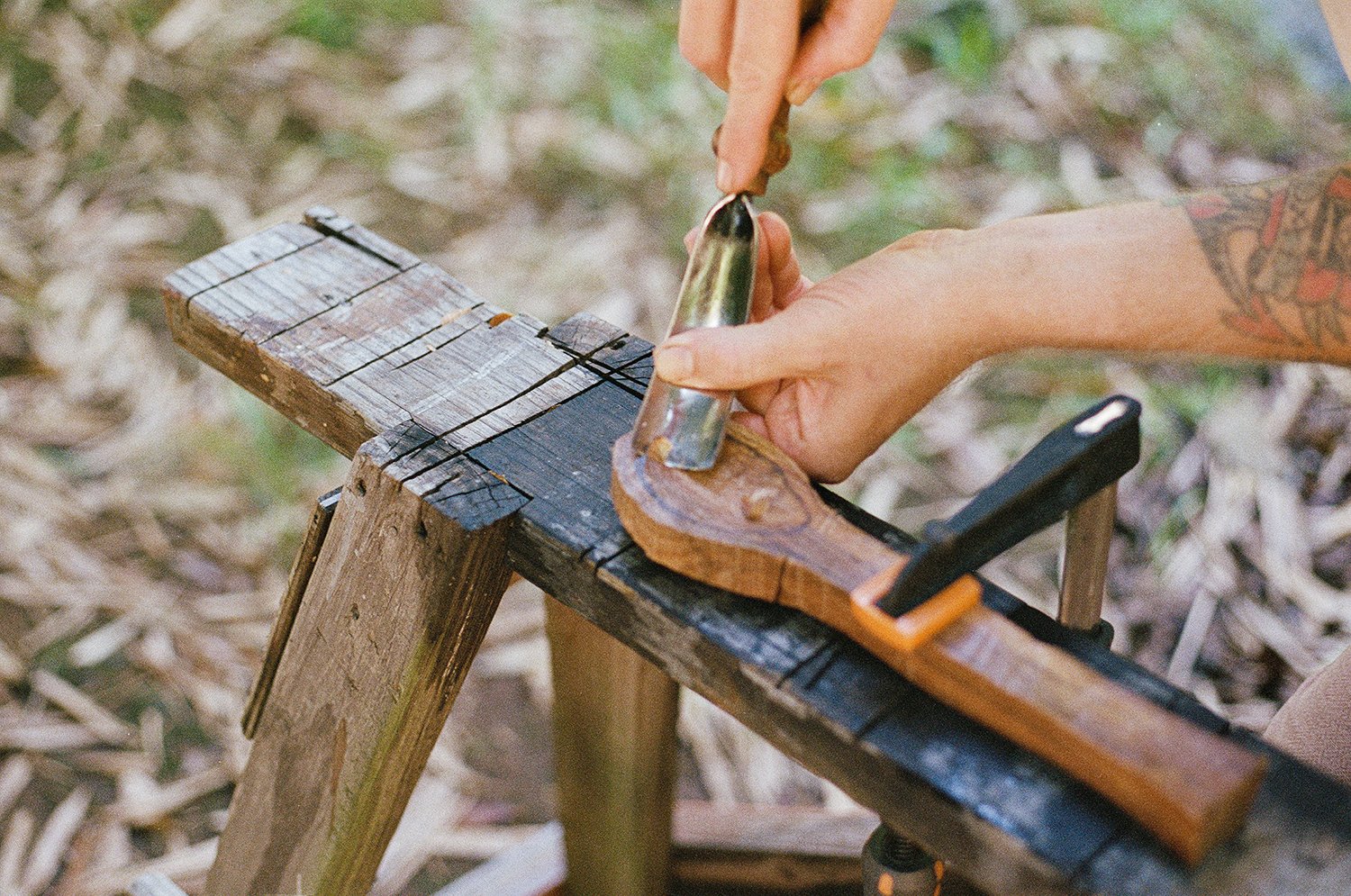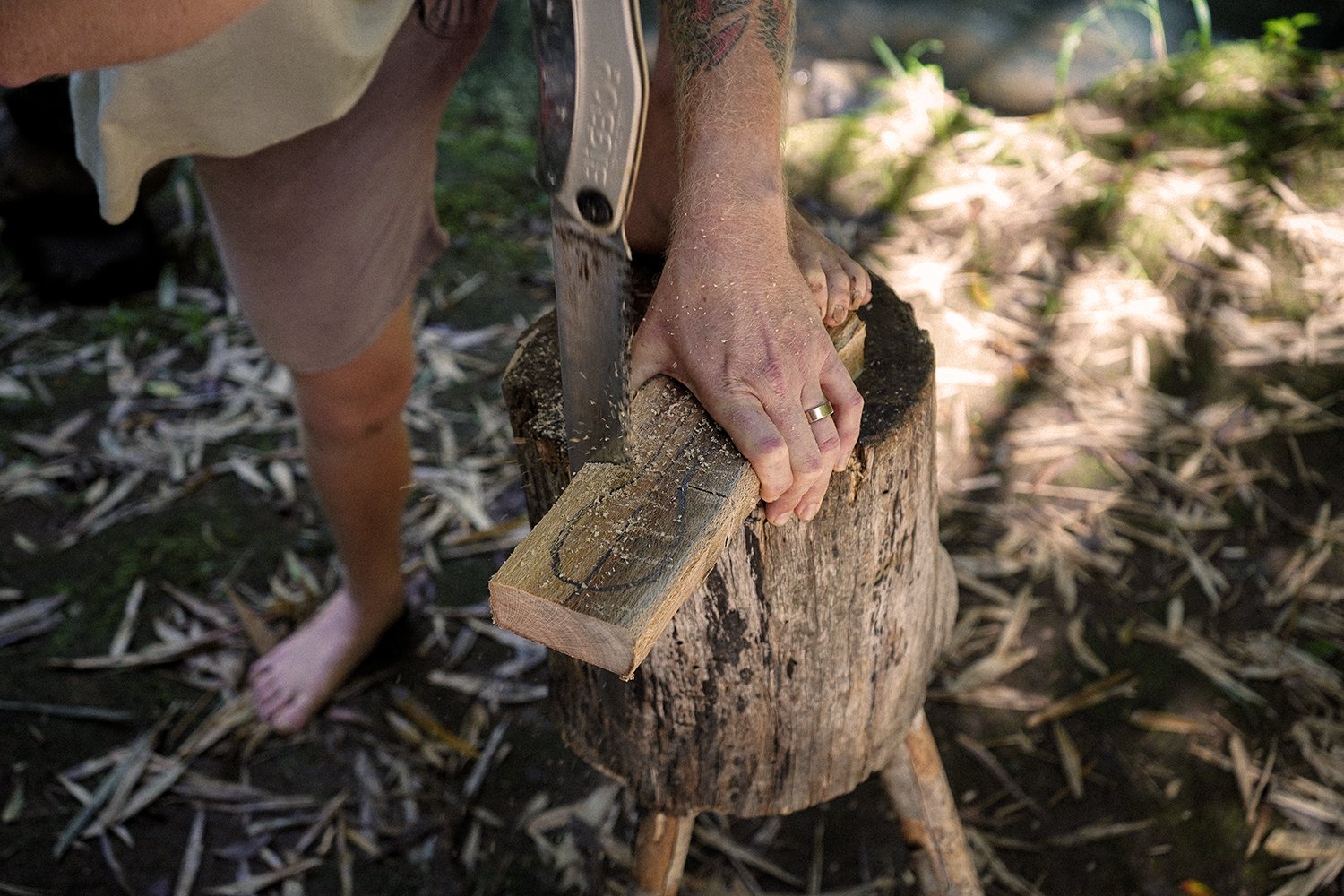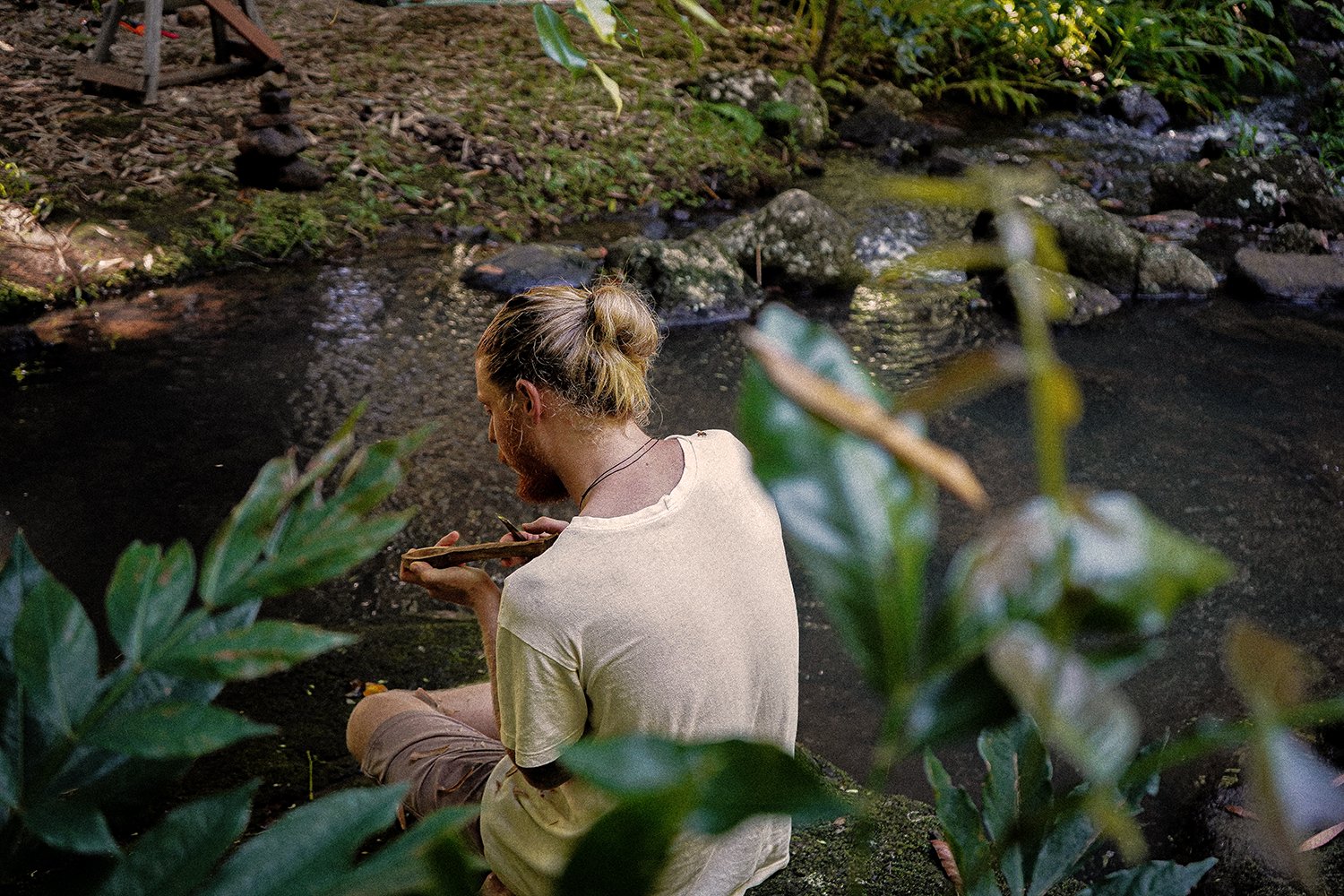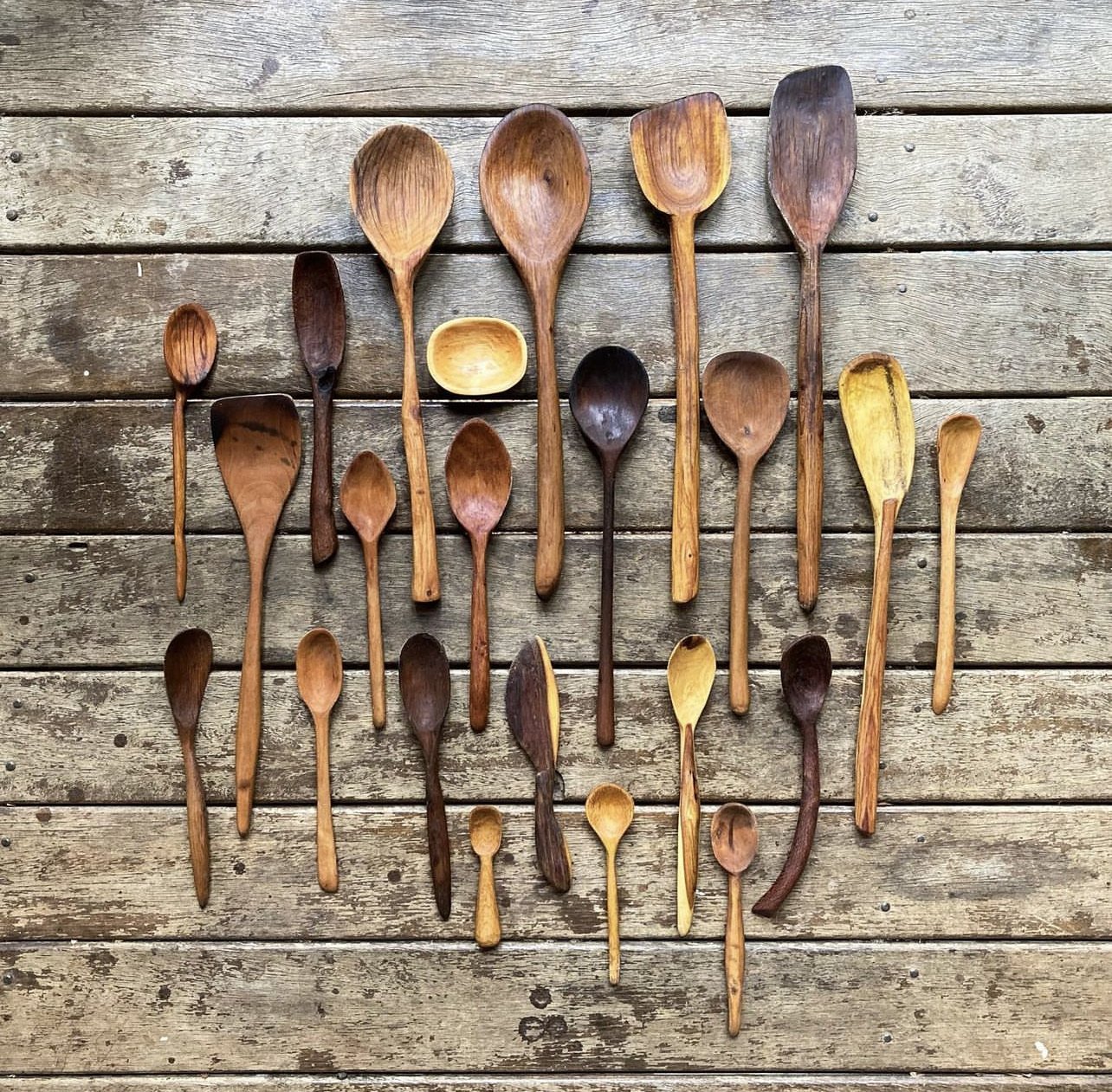Spoon Carving with Daniel from Spoon Baba
Meet Daniel - The maker behind Spoon Baba. Daniel and I met several years ago at a cooking class I was running in Gerringong.
Not only is he a talented carver, he is a great cook. He makes his spoons using traditional methods and hand tools only. His wood comes from storm fallen branches which he has collected and trees that need pruning, or have been cut down by others which he is given and stores for future use.
Daniel down by the creek in Goonengerry, where he spends his time carving.
What was the trigger or influence that got you into spoon carving?
You know it’s funny…I found an old journal from not long after Bhavani (my daughter) was born where I had this vision of travelling around carving spoons and selling them on the roadside. I had completely forgotten that I’d written that, then when the big flood happened in 2022, we moved down to the Central Coast Hinterland for a little while. There was a guy there who I call my woodwork guru, his name is Nirvana. He lives in a beautiful tiny house and has a big workshop on the land we were living. He is a wealth of knowledge and invited me to come and spend some time with him in the workshop and asked me what I wanted to make.
I saw he had a lathe, so the first thing I made was a rolling pin. I made two of them out of this beautiful old hardwood that he’d found on 100 year old property with blacksmith nails still intact that we had to pull out. That experience got me hooked. I love to cook and I love to make and be creative, so I said the next thing I want to make is a cooking spoon or a ladle. He told me to find a limb on a nearby fruit tree that needs pruning and bring it to him and we’ll make something together. It took me a few days to find the branch. I noticed myself stopping and looking at nature in more depth, appreciating the natural form and what the branches could become.
I found the branch I wanted, it had fallen in a storm. It was lilly pilly. I got the saw and starting cutting into it, then I dropped the saw on my foot and I started bleeding. It was kind of incredible really, like an initiation. In that moment, I was giving back to the Earth, as I was evidently taking from it. Give and receive…
Nirvana really showed me the ropes, he let me borrow his axes that he’d shaped in a way to make them perfect for carving. He carves a lot of sculpture, so he changed the bevels to make them carve the wood a lot smoother. He taught me how to do this on my own axe. He taught me a lot, he’d basically tell me what to do next and then leave me alone to develop my own techniques and style. He was such a great influence and really encouraging. I then carved a little teaspoon for my daughter, she was teething at the time and the wood was non-toxic. She’d chew on it. I loved that the wood was from the land that I lived on. It was a harsh winter there, I spent the entire winter carving. I remember the smell of wood smoke, the view over to mangrove creek whilst whittling away.
I started to get friends and people around me asking if I could make spoons for them. So it started there. I started gifting spoons to family and friends. Then it grew…
Shaving out the bowl…
That’s beautiful…Where do you source your wood from?
So mainly I source it from storm fallen branches or when my landlords or friends have been trimming, pruning or needing to cut a tree down. I have a beautiful network of people that let me know when they have some fresh green wood, you being one of them. Fresh cut green wood is the best to use for carving as it’s softer and doesn’t have cracks.
I go there as fast as I can to pick it up and store it away with some paint on the ends to keep the moisture inside. Another way I love to get wood is to go bush walking after some heavy winds or a storm and I often find fresh branches that have fallen off the tree. That is very much working with nature. There’s no human intervention of having to cut a tree down unnecessarily. I find I am often cleaning up after people or storms. Sometimes it’s tragic, a big storm can cause a lot of damage. I take a little piece of that and turn it into something beautiful and functional, a tool to be used to cooking or eating.
There was a red ash tree cut down around the corner from where we used to live and the tree loppers left a heap of it on the side of the road. I filled my boot up and have probably made 50 spoons from that wood. You don’t need much wood to make a lot of spoons. I love to use every piece of the wood I can and try not to let any go to waste. In saying that, I know wood is in abundance around us, but it’s an ethical thing for me…
You can find Daniel’s work;
Instagram - @spoon.baba
Website - www.spoonbaba.com
He also sells his work at local markets in the Northern Rivers of NSW, Australia and is available for custom orders.
// Interview & Photography - Cade McConnell
“One aspect of carving spoons I love is that my daughter, gets to see me doing real work. She wants to be a part of it. She wants to learn to carve. It’s so wholesome to be following a craft that the whole family can be involved in.
I shape the wood and the wood shapes me.”
Carrying a log of macadamia wood down to the creek to turn into spoons.
Sawing off the dried end piece to access the softer green wood inside.
What is a lesson that the branches or wood has taught you?
That’s a really good question…Something I am always astounded by is the hidden beauty in every natural object. Especially when I first have the axe and split the piece of wood open and reveal the treasures hidden inside, it’s incredible. Amazing knots, psychedelic colours and often patterns from insects living inside causing ‘deformations’, fungal spores creating beautiful marks. It’s perfect.
The wood has taught me that there is beauty in all aspects of life, even the gnarly bits. Actually, especially the gnarly bits. I carry a deep respect for the wood and the land which the trees have grown on. If I can give this wood second life then I can nourish my family through the income I make spending time making.
The splitting block - made from a eucalyptus stump and the legs are from davidson plum wood.
What does a spoon carving day look like for you?
For me, most of my carving happens when my daughter is asleep. I find I can get into that no-mind peaceful state when I am on my own. That’s when I can make the most beautiful pieces, when I don’t have the distractions of being interrupted. Basically, every time my daughter naps, I get straight into the carving. It becomes my rest time too, even though it is quite physically demanding, dropping into presence is quite restful for me.
I will get up in the morning and do my sadhana - meditate, asana and then sit and have a cup of tea and do some carving. I love to walk down to the creek and have a dip first. On the rare occasion we get to, I have a cuppa with my wife on the front step and I carve, we talk and check in. Some days I get more done than others, especially if my wife and daughter are out on an adventure. Other days I make spoons when we are all together - swimming, eating, carving, talking, reading.
One of my favourite things to do is when my wife reads to my daughter and I get to listen in while I carve, it’s so sweet.
Do you have a preferred wood to carve, or is there a certain wood that you feel most connected to?
Australian natives are definitely my favourite. Though I do mostly love to carve black wood acacia or hickory wattle because they are abundant, they are strong woods but carve quite nicely. I love the grain and colours. They can have reds, maroons, browns and chestnut, all these amazing colours and that’s the heartwood which is surrounded by a lovely creamy more pale wood. You don’t even have to make an intricate spoon, you can make the most basic spoon and it’s a master piece. You just have to allow the woods natural beauty to be shown.
As Australia doesn’t have its own known history of carving in the same way that Scandinavia does or other European cultures do. I would say that my technique is very much derived Swedish culture, which is where my wives heritage.
I used to work in horticulture in a nursery. I can name thousands of plants in Latin and I know the plants around me. To be able to get to know them on a deeper level through carving and working with the wood is incredible. Nobody knows what the inside of every lilly pilly, acacia or she-oak looks like. It’s always a mystery.
How does it feel to be working with your hands?
I feel it is extremely important to me. I feel like so much of modern life is in the mind and that is something that really gets to me, it bothers me. I have always been drawn to crafts and art and ways of living that incorporate natural movement and using my hands because like I said earlier, it allows me to get out of the mind and tap into a more primal part of myself, a deeper place within myself that cuts away all the modern bullshit that suffocates our lives.
I love to see the scars I have from learning, from the slips and mistakes. I have calluses on my hands which act like I am wearing a glove. I shape the wood and the wood shapes me. Using my hands is a privilege, they were made to be used.
A collection of Daniel’s work









